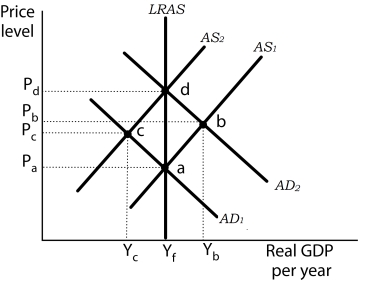Multiple Choice
Figure 11-6 
-Refer to Figure 11-6. Suppose the economy is operating atpoint a. Some people observe that an expansionary monetary policy will increase the money supply and ultimately drive the price level to the equilibrium at
A) d. They rationally adjust their behavior and the aggregate demand curve shifts to the left and d becomes the new equilibrium point.
B) b. They rationally adjust their behavior and the aggregate demand curve shifts to the left and b becomes the new equilibrium point.
C) d. They rationally adjust their behavior and the short-run aggregate supply curve shifts to the left and d becomes the new equilibrium point.
D) c. They rationally adjust their behavior and the short-run aggregate supply curve shifts to the left and d becomes the new equilibrium point.
Correct Answer:

Verified
Correct Answer:
Verified
Q33: Which of the following result from a
Q39: All other things unchanged, we expect that
Q69: If inflation is a threat, then the
Q98: Which lag stems from the fact that
Q128: Define and explain the three lags discussed
Q129: Figure 11-5 <img src="https://d2lvgg3v3hfg70.cloudfront.net/TB5507/.jpg" alt="Figure 11-5
Q135: Figure 11-6 <img src="https://d2lvgg3v3hfg70.cloudfront.net/TB5507/.jpg" alt="Figure 11-6
Q145: When the Fed buys bonds in the
Q161: When the Fed buys bonds in the
Q165: Which of the following is an interest